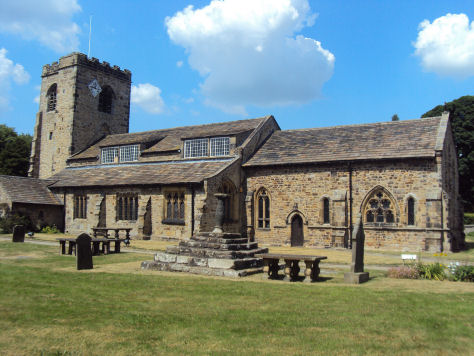Ribchester
OS grid ref:-SD649353
The unique village of Ribchester is situated in the Ribble Valley in Lancashire. It lies on the banks of the River Ribble, northwest of Blackburn and to the east of Preston. The village boasts a long history being first occupied during the Bronze Age, a number of burial urns were discovered near the village car park which date to the Bronze Age, some 3,500 years ago.
The River Ribble at Ribchester and the seventeenth century White Bull Inn


Ribchester was also the site of the Roman fort of Bremetenacum Veteranorum founded by General Agricola, some parts of which have been excavated. The first fort to occupy the site was a timber structure built between 72 and 73 A.D. by the Twentieth Legion set on a network of roads leading out to Chester, Manchester, Lancaster and York.
The fort was rebuilt in stone in the early second century, it was a large fort measuring about 6 acres (24,000 m2) and garrisoned by around 500 cavalry. A fort remained at Ribchester until the fourth century, its remains can still be seen around the village today. Ribchester's three-arched bridge, constructed in 1774, stands astride the old Roman ford.
Roman Stones outside the museum and St. Wilfrid's Church


The characterful White Bull Hotel at the centre of the village dates back to 1707 and is a grade II listed building. The imposing entrance is flanked by four complete ancient Roman pillars, which are thought to have come from the Roman temple of Minerva. The frontage also boasts original cobbles and a three step mounting stone, once used by guests to step down from their horses or carriage. The pub offers fine dining, pub meals, accommodation and cask ales.
The ruins of the Roman bath houses are visible near the White Bull Pub, a section of the northwest rampart of the fort and defensive ditch are also visible along the footpath leading to the public car park.
St Wilfrid's Church
The church of St Wilfrid dates from the thirteenth century, a chapel and porch were added in the fourteenth century and the Perpendicular tower in the late fifteenth century. At the rear of the church is a gallery which is supported by what are thought to be two Roman pillars while on the north wall of the chapel are the remains of a fourteenth century wall painting depicting St Christopher carrying the Christ child.
The Church interior and the fourteenth century wall painting on the north wall


The octagonal sandstone font is probably of fourteenth century date. The Jacobean style oak pulpit dates back to 1636. On the north wall of the building is a hole known as a Hagioscope or Leper's Squint. This allowed "infected" people to watch the services without risk of them contaminating the rest of the congregation. Finds on the site of a Saxon coin and small fragments of a Celtic cross suggest that there was an earlier church once occupied the site.


 Ribchester Roman Museum was built above the remains of the headquarters building of the Roman Fort in 1914. Roman Ribchester is brought to life by dramatic displays, which include a life size cavalryman, Roman legionary and interactive exhibits. Exhibits including weaponry, jewellery and leatherwork and a replica of the Ribchester Helmet. The remains of the Roman granaries are also open to visitors. The museum organises school and adult party visits, including evening tours, throughout the year.
Ribchester Roman Museum was built above the remains of the headquarters building of the Roman Fort in 1914. Roman Ribchester is brought to life by dramatic displays, which include a life size cavalryman, Roman legionary and interactive exhibits. Exhibits including weaponry, jewellery and leatherwork and a replica of the Ribchester Helmet. The remains of the Roman granaries are also open to visitors. The museum organises school and adult party visits, including evening tours, throughout the year.
The Ribchester Hoard was found in the summer of 1796 by the son of Joseph Walton, a clogmaker. It included the most famous artifact discovered in Ribchester, a Roman bronze ceremonial cavalry helmet dating to between the late 1st and early 2nd centuries AD., which may have had a sphinx attached to the top, the sphinx, although once in Townley's possesion, is now lost. The boy found the hoard buried in a hollow near the river bed, around three metres below the surface, by the side of a road leading to Ribchester church. In addition to the helmet, the hoard included a number of patera, pieces of a vase, a bust of Minerva, fragments of two basins, several plates, and some other items thought to have had religious uses. It was thought to have been stored in a wooden box.
The hoard was purchased from Walton by a local antiquarian, Charles Towneley of nearby Towneley Hall, the helmet was later sold to the British Museum by the cousin of Towneley, where it can be seen on display today. The helmet is decorated with a scene of a skirmish between infantry and cavalry. When in use, the head-piece and face mask of embossed bronze would have been held together by a leather strap. A crest-box and a pair of trailing streamers or 'manes' would have been attached to the head-piece.
Nearby Places of Interest
Stydd- hamlet situated on the north eastern edge of Ribchester.
Whalley Abbey- founded by Henry de Lacy, third Earl of Lincoln on the 4th April 1296.
Lancaster Castle founded in the tenth century
Ashton Memorial in Williamson Park, Lancaster was commissioned by James Williamson, Baron Ashton as a tribute to his second wife, Jenny and was built between 1907 and 1909.
